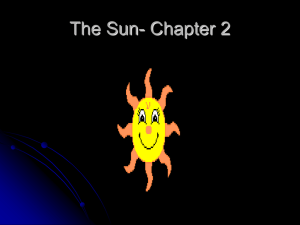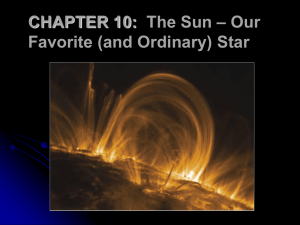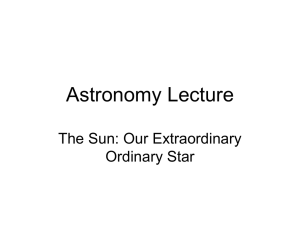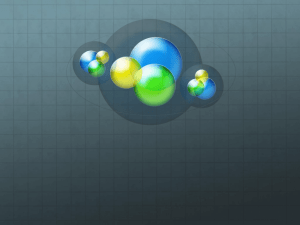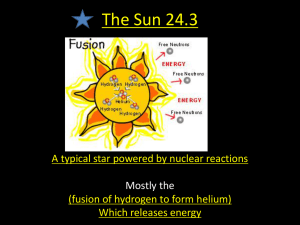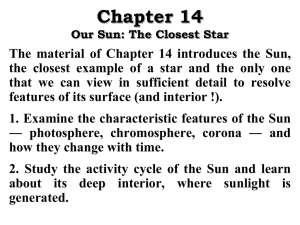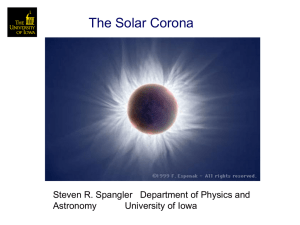Notes: Sun
advertisement
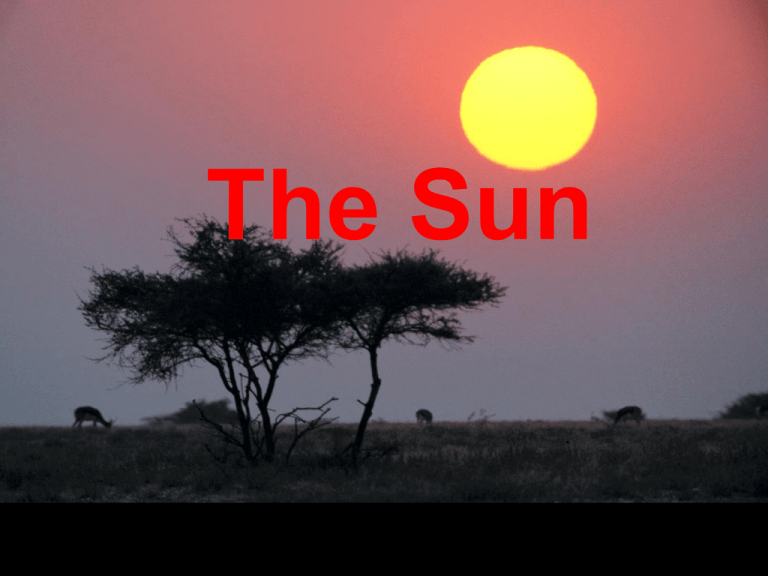
The Sun 1 Guiding Questions 1. Does the Sun have a solid surface? 2. Since the Sun is so bright, how is it possible to see its dim outer atmosphere? 3. Where does the solar wind come from? 4. What are sunspots? Why do they appear dark? 5. What is the connection between sunspots and the Sun’s magnetic field? 6. What causes eruptions in the Sun’s atmosphere? 2 Introduction Table 13-1 3 Photosphere The photosphere is the lowest of three main layers in the Sun’s atmosphere Fig. 13-1: The Photosphere • The Sun’s atmosphere has three main layers: the photosphere, the chromosphere, and the corona • Everything below the solar atmosphere is called the solar interior • The visible surface of the Sun, the photosphere, is the lowest layer in the 4 solar atmosphere Convection in the photosphere produces granules Fig. 13-3: Granules 5 Fig. 13-4: Supergranules 6 Chromosphere The chromosphere is characterized by spikes of rising gas • Above the photosphere is a layer of less dense but higher temperature gases called the chromosphere • Spicules extend upward from the photosphere into the chromosphere along the boundaries of supergranules Fig. 13-5: Chromosphere 7 Fig. 13-6: The Solar Atmosphere 8 Corona The corona ejects mass into space to form the solar wind Fig. 13-8: The Solar Corona 9 Activity in the corona includes coronal mass ejections and coronal holes Fig. 13-9: The Ultraviolet Corona 10 Sunspots Sunspots are low-temperature regions in the photosphere Fig. 13-10: The Sunspots 11 Fig. 13-11: The Sun’s Rotation with Sunspots 12 Fig. 13-12: Sunspot Maximum and Minimum 13 Sunspots are produced by a 22-year cycle in the Sun’s magnetic field Fig. 13-13: The Sunspot Cycle 14 Fig. 13-14: Variations in the Average Latitude of Sunspots • The Sun’s surface features vary in an 11-year cycle • This is related to a 22-year cycle in which the surface magnetic field increases, decreases, and then increases again with the opposite polarity • The average number of sunspots increases and decreases in a regular cycle of approximately 11 years, with reversed magnetic polarities from one 11year cycle to the next 15 • Two such cycles make up the 22-year solar cycle Sun’s Magnetic Fields Fig. 13-15: Mapping the Sun’s Magnetic Field The magnetic-dynamo model suggests that many features of the solar cycle are due to changes in the Sun’s magnetic field 16 Fig. 13-16: Sunspots and Magnetic Fields 17 Fig. 13-18: Rotation of the Solar Interior 18 Other Magnetic Activities The Sun’s magnetic field also produces other forms of solar activity • Solar Flares: A solar flare is a brief eruption of hot, ionized gases from a sunspot group • Coronal Mass Ejection: A coronal mass ejection is a much larger eruption that involves immense amounts of gas from the corona Fig. 13-19: Magnetic Arches in the Corona 19 Prominences, Filaments, Plages Fig. 13-20a: Prominences, etc - I. 20 Fig. 13-20b: Prominences, etc - II. 21 Fig. 13-21: Coronal Mass Ejection 22 Internal Solar Layers 23 Nuclear Fusion ! • At 15 million degrees Celsius in the center of the star, fusion ignites ! • 4 (1H) --> 4He + 2 e+ + 2 neutrinos + energy • Where does the energy come from ? • Mass of four 1H > Mass of one 4He E = mc2 24 A Balancing Act • Energy released from nuclear fusion counter-acts inward force of gravity. Throughout its life, these two forces determine the stages of a star’s life. 25 • • • • • • • Key Words 22-year solar cycle • Fusion chromosphere • granule conduction • photosphere Convection • plasma Convection zone • Prominence core • Radiation zone corona 26
